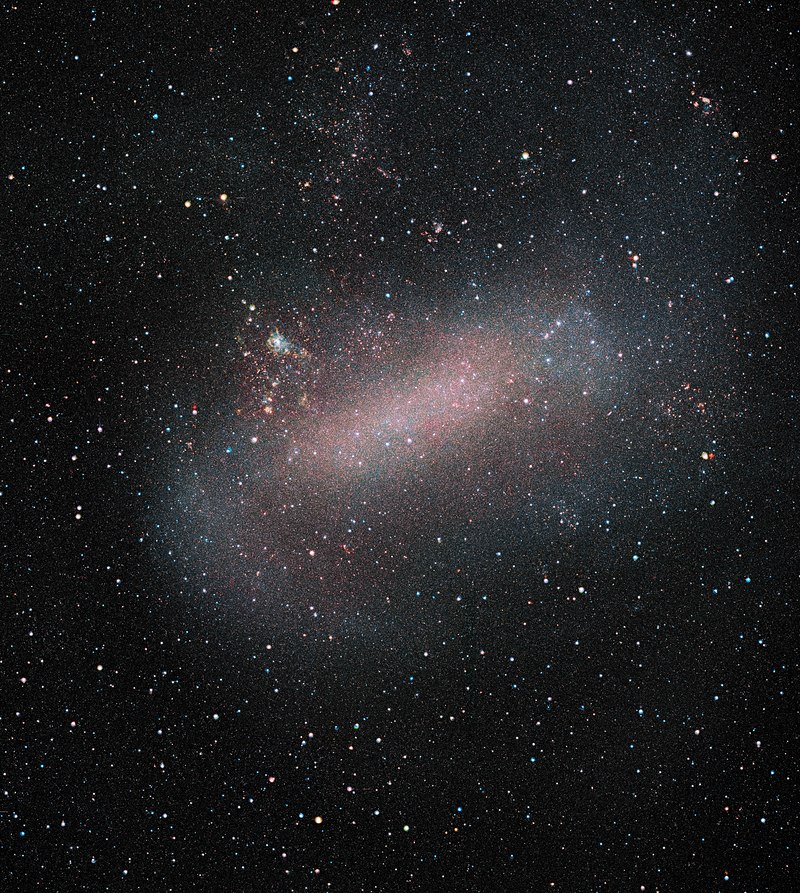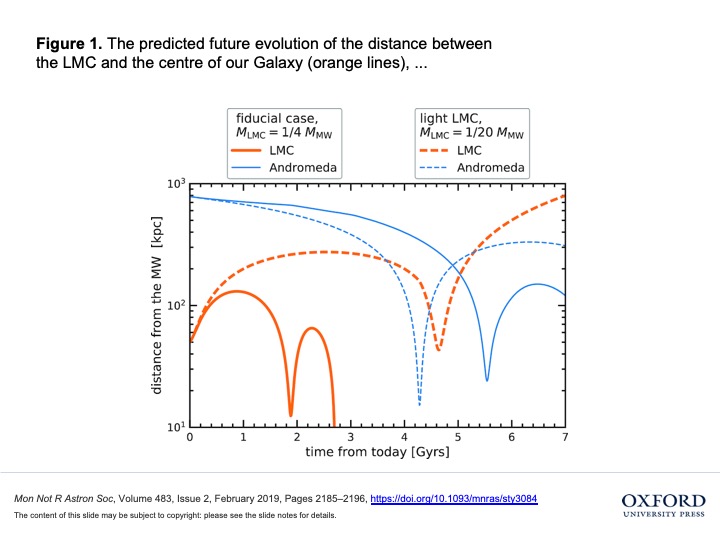= ASTRONAUTICAL EVOLUTION =
Issue 155, 7 July 2020 – 51st Apollo Anniversary Year
| Site home | Chronological index | Subject index | About AE |
Read this post on Wordpress if you wish to leave a comment
Voyage to the Large Magellanic Cloud
Will intergalactic travel ever be possible?
Here’s a question that grabbed my attention recently. Let’s leave to one side fantasy propulsion systems – space warp engines that can supposedly propel a spacecraft faster than light, interstellar ramjets that can accelerate at a constant one gee for decades on end, and suchlike. Let’s dismiss the perpetual motion machines of resonant cavity thrusters and EM drives supposedly pulling energy and momentum for free out of the quantum vacuum, or the intriguing but (to me) incomprehensible theory of quantised inertia, and stick to physics that’s known and tested today.
Would our descendants then be confined forever within the bounds of the Milky Way galaxy plus, looking some billions of years into the future, the other members of the Local Group when they eventually coalesce into one supergalaxy?
I suggest the Large Magellanic Cloud as our test case. This is the fourth largest member of the Local Group after the Milky Way itself and the Andromeda and Triangulum spiral galaxies.
It’s not the closest to the Milky Way: that honour goes to the disputed Canis Major Overdensity, or to the Sagittarius Dwarf Spheroidal/Elliptical Galaxy. But the distances of these from the centre of the Milky Way, at 42,000 and 50,000 light years respectively, are no greater than the radius of the disk of the Milky Way itself, at around 50,000 light years. Some astronomers have argued that the Canis Major cluster is no more than part of the Milky Way’s own halo, while the Sagittarius Dwarf is, given its distance and direction, clearly more or less in contact with the far edge of the main disk of the Milky Way as seen from our own position.
The Large Magellanic Cloud is therefore the closest external galaxy which is separated from the Milky Way by a clear gulf of intergalactic space, ruling out any chance of star hopping to get there.
A recent paper estimates the motions of the Large Magellanic Cloud and the Andromeda Galaxy relative to the Milky Way for the next seven billion years (see figure below). The LMC is in fact currently moving away from us and will continue to do so for at least a billion years to come. However, on a human timescale these movements are achingly slow (about 120 km/s, or one light year in 2500 years), and over the next few million years its distance will not change by much.
It is currently 163,000 light years from the Sun. A little geometry shows that it is 123,000 light years from the rim of the Milky Way’s disk, and since its diameter is 14,000 light years the minimum distance to be crossed, starting from a star in our own galaxy which would be 56,000 light years from the Sun, must be about 116,000 light years. Even taking remote stragglers into account, we are clearly looking at a voyage of at least 100,000 light years through empty intergalactic void.
Crossing that, then, is the challenge!
Travelling in a spacecraft
How fast might an interstellar spacecraft be able to go, and how long would it take to cross 100,000 light years? Due to the limiting speed of light, the absolute minimum time would be somewhat greater than 100,000 years, but that’s galactic time, or star time. In a fast-moving ship, the time will be reduced due to relativistic time dilatation.
The reduction is by a factor of γ (gamma) and is not actually all that impressive. For travel at half the speed of light (c), γ = 1.155, so the journey time, ignoring time spent accelerating at the start of the journey and decelerating at the end, is 200,000/1.155 = 173,000 years ship time.
At 90% of c, we have γ = 2.294 and the journey time is 48,000 years ship time.
At 99% of c, we have γ = 7.089 and the journey time is 14,000 years ship time.
Can such a speed even be reached using known physics? For a rocket-propelled vehicle, the most mass- and energy-efficient propulsion system conceivable is one using matter-antimatter annihilation. Supposing the most energy-efficient mass ratio of 5, and a propellant which is 10% antihydrogen (optimistically high, given the difficulties of containing antimatter so that it does not react prematurely, and of converting its annihilation products to thrust). Then a one-million-tonne ship at departure from the last outpost of the Milky Way will have 200,000 tonnes for payload, engines and tanks, and carry 720,000 tonnes of, presumably, hydrogen, and 80,000 tonnes of antihydrogen.
Assuming an engine which is 100% efficient (!) the exhaust velocity would then be two-thirds of c and the total velocity change, calculated from the relativistic rocket equation, is 0.79 c. Of course half of that is required for deceleration on arrival, giving a cruising speed of around 40% of c, whence γ = 1.091 and the journey time is 229,000 years ship time.
Perhaps the ship might carry a giant sail which is pushed by the beam from a laser installation stationed at the departure star? The ship still has to decelerate without the help of any local infrastructure, so it will need its matter-antimatter engine for that purpose, but at least it can then get its cruising speed up to 80% of c, when γ will be 1.667 and the journey time is 75,000 years ship time.
And unless a million-tonne vehicle (or heavier) can be accelerated or decelerated using the incredibly weak magnetic fields and incredibly tenuous gas found in intergalactic space, that really is the best we can do using known physics. Speeds of 90% of c or over seem unattainable, and any realistic journey time is up in the high tens of thousands of years, or more likely well over 100,000 years.
Is there any alternative means of travel?
Travelling with a hypervelocity star
The random mixing of stars in the galaxy occasionally causes a star to accelerate to galactic escape velocity. This is known to happen if two stars forming a binary system pass close to the supermassive black hole at the centre of a galaxy in such a way that they suffer tidal disruption, one star falling into the black hole, the other being ejected from that region of space at high speed (the Hills mechanism).
Here, for example, is a report on the discovery in 2005 of a massive (8 solar masses) hypervelocity star, B-type spectrum with apparent magnitude 16.3, HE 0437-5439, ejected either from the Milky Way or from the Large Magellanic Cloud. Some discussion in the Wikipedia article gives more details: the star is 200,000 light years away, which puts it well beyond the LMC, and is flying away from both the LMC and the Milky Way at over 700 km/s, greater than galactic escape velocity.
A more recent discovery (2020) describes another massive star (2 solar masses), with A-type spectrum, at a distance of 29,000 light years from the Sun and travelling out of the Milky Way at over 1700 km/s, ejected from the galactic centre. Clearly, the fact that these stars were spotted at all is due to their intrinsic brightness: both are much hotter and more massive than the Sun.
Might there also be cooler, sunlike hypervelocity stars? Perhaps with planets?
One of my current science fiction projects – working title The Gods of Ultima Landra – is based on the idea that a sunlike star is found leaving the Milky Way in the direction of the Large Magellanic Cloud. If travelling with a speed of 1500 km/s, 0.5% that of light, it will take about 20 million years to cross 100,000 light years of empty intergalactic space.
It is perhaps stretching plausibility a bit to give this star a planetary system, after the gravitational vicissitudes it must have been through to eject it at such a high speed, but it makes for a better story. Ultima Landra itself has Earth-like surface conditions, after a considerable terraforming effort. Also important are the largest satellite of the giant planet, and the asteroid belt: all three locations support human settlement.
The importance of having multiple locations is that, as we discussed in the previous post, history doesn’t stop just because a society becomes industrialised and prosperous. It may be that all civilisations, no matter how technologically advanced, are destined to collapse within a period of time very much less than 20 million years. A single civilisation, then, would not survive the journey to the Large Magellanic Cloud on a hypervelocity star. Even the society on board a single intergalactic starship, which might make the journey in as little as 100,000 years, would be more than likely to die out before arrival.
But in a planetary system there is space and resources to support several independent civilisations. So long as they don’t all go into decline at the same time, then as one falls, another can survive and reboot the collapsed settlement from outside.
But will the inhabitants of even the most prosperous civilisation keep alive the memory of who they are and where they are going over a period of time in the tens of millions of years? And won’t they evolve into new species, or become their machines, or separate out from their machines again, over such a vertiginous timespan?
Meanwhile, some of the more adventurous astronautical thinkers have described systems which they call stellar engines: machines for accelerating a star, together with any planets it may have, in a desired direction. Might this technique get us to the Large Magellanic Cloud any faster? Or perhaps further afield, to its smaller sibling the Small Magellanic Cloud, or to the Andromeda or Triangulum galaxies? I shall address this question in the following post.
To make comments, please visit this post on Wordpress.
| Site home | Chronological index | About AE |

